After a long flight from South America, a bird could use a juicy meal and a place to rest, right?
For purple martins, those tasty insects and summer lodgings could be in your yard, if you offer these attractive and melodious birds a proper residence.
With the exception of a limited range in the far northwest, the birds have crossed the western United States off their summer destination list, though they still return each spring to the eastern part of the country.
Their arrival is eagerly anticipated by homeowners who appreciate the birds’ entertaining and useful attributes, some hoping to take advantage of the birds’ reputation for enjoying thousands of mosquitoes per day. But more on that later.
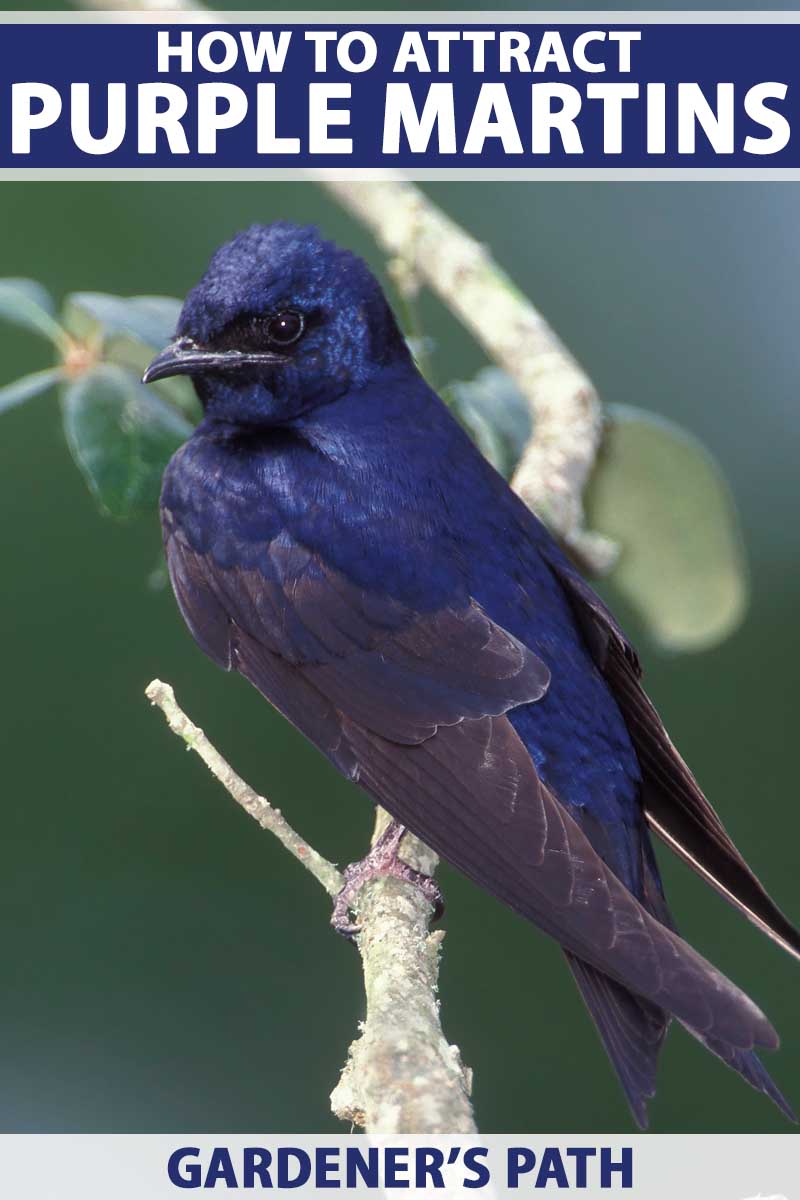
We link to vendors to help you find relevant products. If you buy from one of our links, we may earn a commission.
Let’s learn more about this alluring species and then learn how to attract them to your gardens.
What You’ll Learn
Introduction: Meet the Martins
Purple martins are the largest member of the swallow family to call North America home. They’re nearly 8 inches long and have a wingspan of 15.4 to 16.1 inches.
The species gets its name from the males — they sport deep blue-purple, iridescent feathers. The ladies wear considerably less showy brown-gray feathers.

These birds like nothing more than a tasty insect snack. According to the Audubon Society, they feed on a wide variety of flying insects, “including many wasps and winged ants, and some bees.”
They also eat house flies and crane flies, beetles, moths, and butterflies. And while they do indeed eat mosquitoes, they do not consume the huge numbers the legends say they do.
It takes a lot of effort to capture the number of mosquitoes that would equal a single moth, for example. So, like many of us, they are more inclined to go for the easy meal.
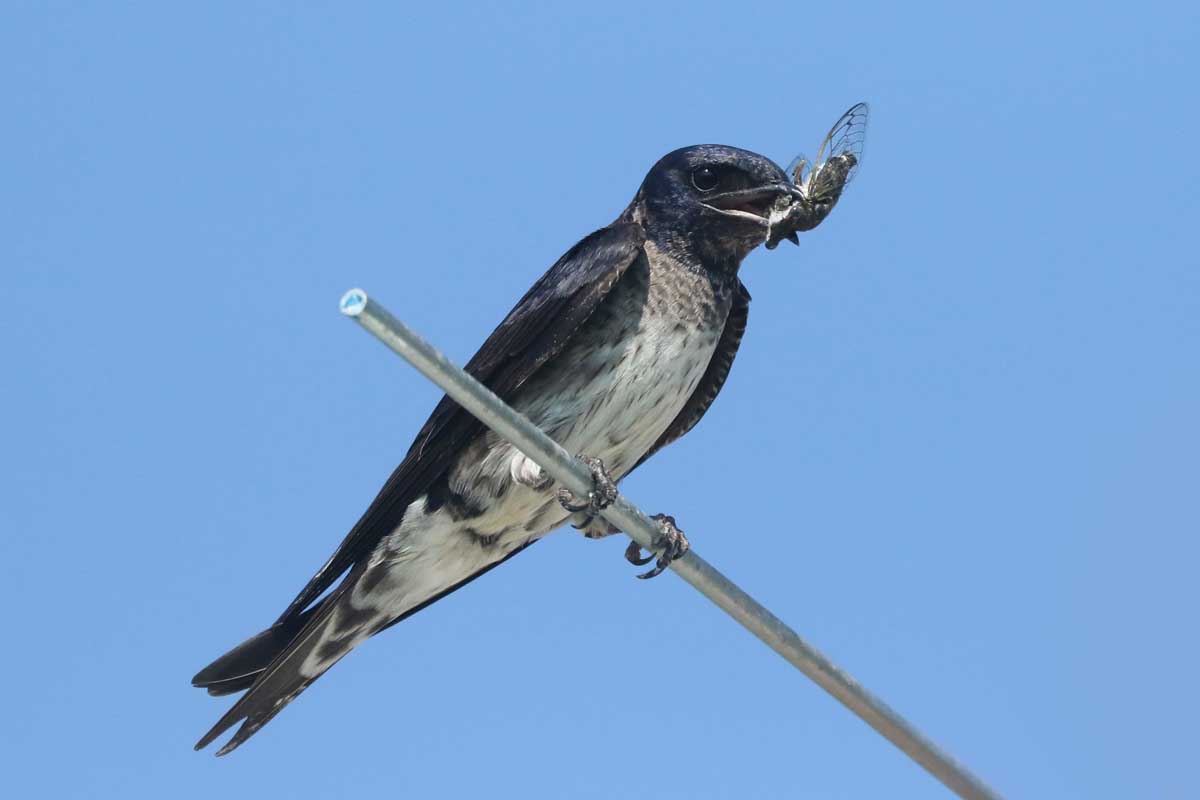
For the most part, they eat midflight, twisting their bodies and wings just so to corral their prey, earning their reputation as talented aerobatic artists.
Summertime All the Time
Obviously partial to warm weather, purple martins arrange their travel schedule so that they enjoy spring and summer in the northern hemisphere, and then head south to enjoy the warm season in the southern hemisphere as well.
I mean, why not, right?
That means they arrive in the southern U.S. as early as February and make it up north in May or June. While here in the U.S., their primary task is procreation, typically producing 4 or 5 eggs in a season.
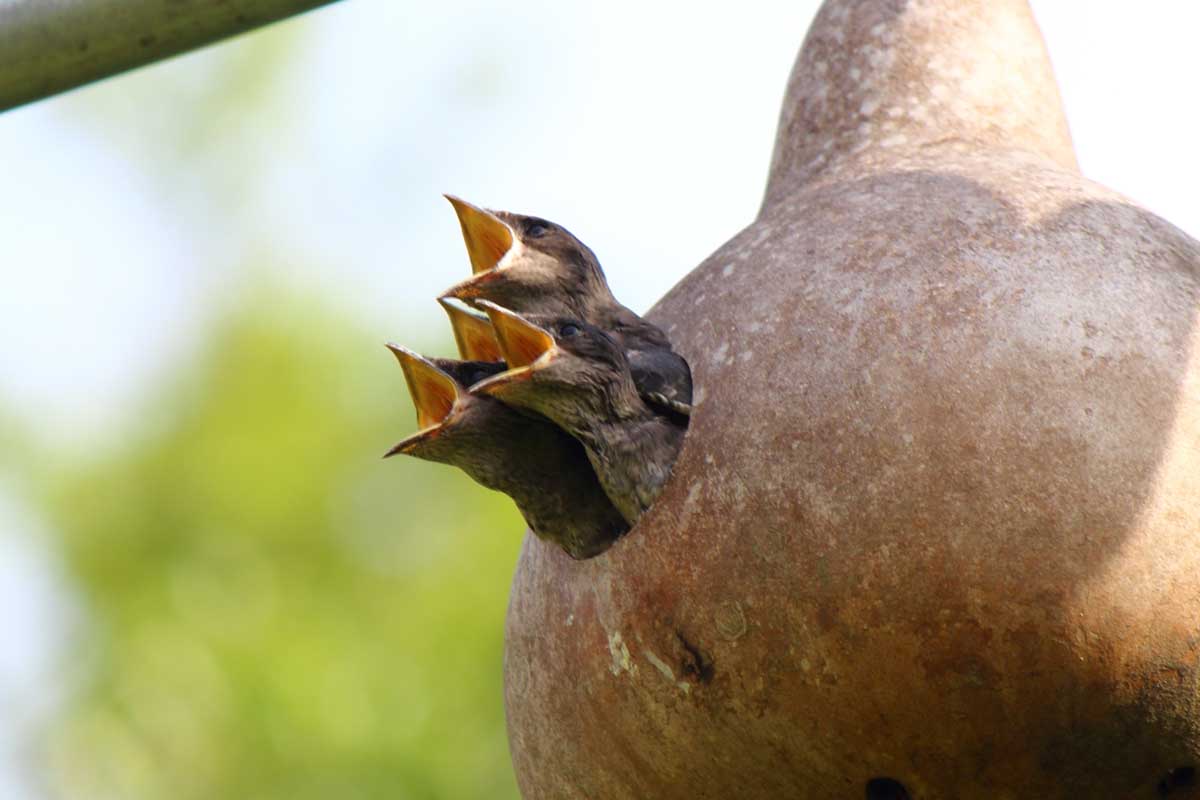
Convincing these birds to expand their families in one’s backyard is a point of pride for many gardeners.
They are appealing not only for reducing pesky insect populations, but also for their lyrical singing and playful flying style, both of which are a joy to behold.
There’s yet another reason you might want to give these birds a place to roost; we’ll get to that later in the article.
The Right Lodging in the Right Location
In the eastern half of the United States, purple martins roost almost exclusively in homes provided to them by humans.
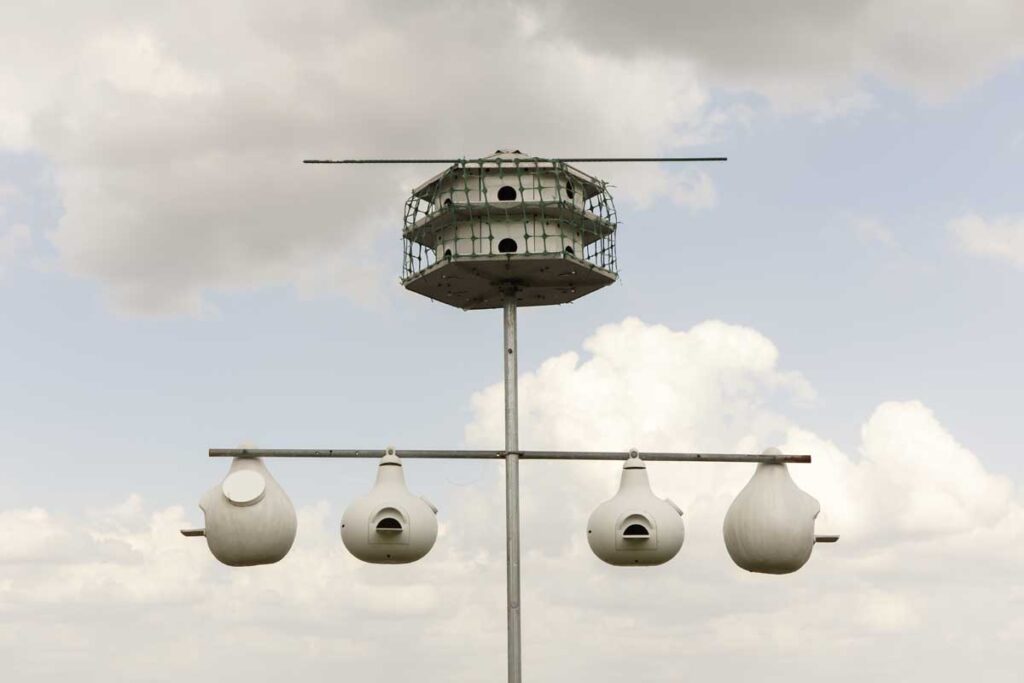
The few who do continue to visit the west nest in woodpecker holes and other natural nooks and crannies. But in the east, it’s up to us to give them a home.
You’ve probably seen those multi-housing units that rise from the earth on a very tall pole, in wide-open spaces.
The birds like these condo-type units, or you can try a natural or manmade gourd with a doorway cut out, another preferred housing type.

Basic Plastic Gourd via Amazon
In fact, Native Americans long ago figured out that these purple fowl like gourd houses, and reportedly hung up hollow gourds around their villages to attract them.
I’ve found that the best plastic gourds are those pictured below. They have an easy to get to capped opening that allows for yearly cleaning. In some of the cheaper models (such as those pictured above), you have to try to clean out old materials through the bird hole. Find them at Tractor Supply Company in packs of six.
Royal Wing Purple Martin Gourd Birdhouses via TSC
Some gardeners hang a combination of condos and gourds to ensure each pair of birds can find the home that’s just right for their family.
Set up your housing units at any height between 10 and 20 feet, and at least 40 feet away from trees, houses, or other buildings that are taller than the height of the martin lodging.
Gourd Birdhouse Bracket via TSC
But don’t place them more than 100 feet away from human housing. Apparently they want to be close to us, just not too close.
In the South, choose white or light-colored housing to reflect the heat of the sun and keep the nestlings cooler.
For your own viewing pleasure, you may want to position the birds’ house in such a way that you can hear and see the creatures from your own comfortable roost, enjoying their songs and aerobatics.
Other Enticements
Ensuring the presence of a few other amenities will help convince these these birds to settle in your yard.
These airborne critters drink and bathe in flight. So having open water somewhere nearby — within a half mile or so — will be a selling point. They don’t drink from bird baths.
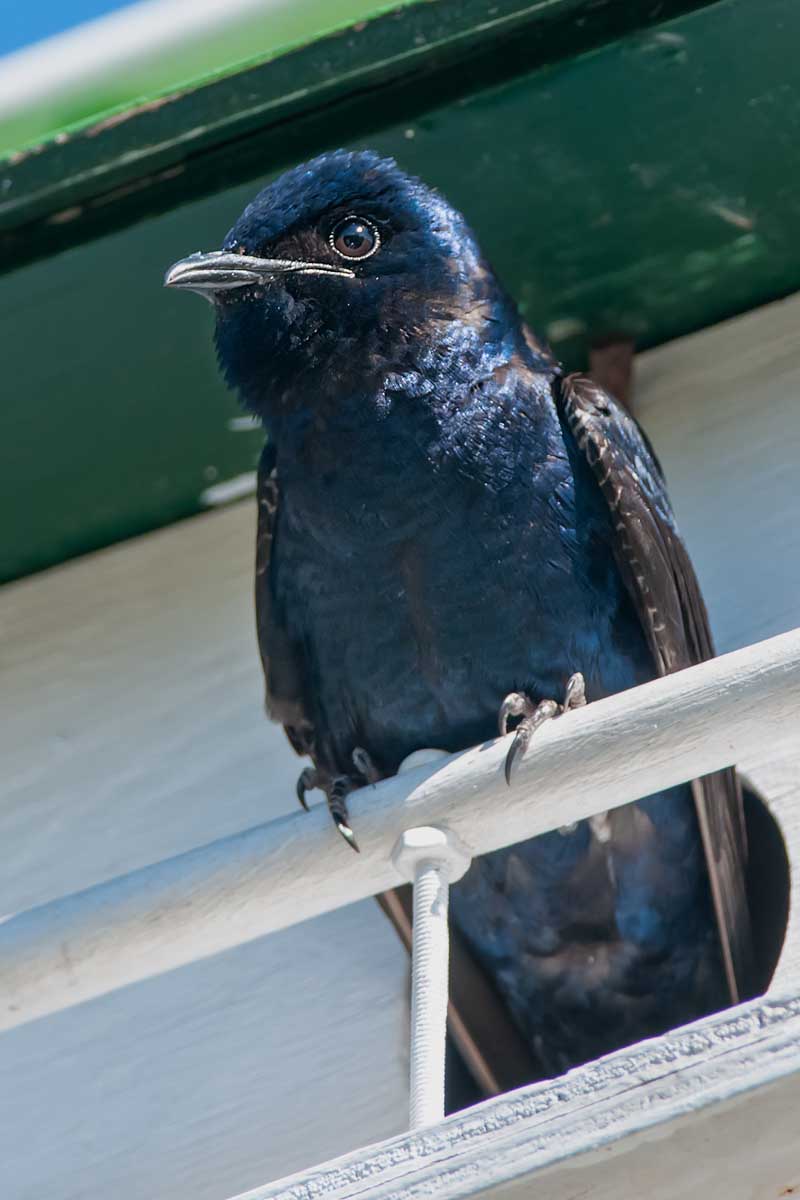
Having bugs for them to eat is always good, and not much of a challenge, eh?
You could offer your condos fully furnished — place 1 or 2 inches of nesting material in the bottom of each compartment. Just make sure it’s fresh, and not last season’s yucky leftovers.
Royal Wing Purple Martin Decoy
Some gardeners add purple martin decoys, like these available from Tractor Supply, to attract the birds, and others play recordings of their “dawnsong” to entice the birds to their yard.
Keep the Interlopers Out and Other Housework
Unfortunately, martins aren’t the only species that will be interested in the wonderful housing you’ve erected.
If you’re not careful, house sparrows and starlings will move into your carefully chosen condos.

24-Room Purple Martin Birdhouse available on Amazon
The only way to avoid this is to time the opening of your condos with precisely the time the martins are looking to settle down. This will vary regionally, of course, so check with local birders for more intel.
If the interlopers do move in, boot them out by removing their nesting materials.
Take your bird houses down each fall — after they’ve left for Brazil and beyond — and thoroughly clean them out. Put them up again just in time to be ready for the next season’s arrivals.
The new arrivals, by the way, will possibly be the same guests who stayed with you the previous season. They remember and come back.
Another Motivation: Save a Species
We told you we’d offer you another reason to invite this species to live with you.
Sadly, populations of this species are declining. Why not do your part to help them rebound?

It used to be that putting up purple martin houses was so common that John James Audubon looked for the houses to determine where he’d stay the night.
In 1831, he is said to have remarked, “Almost every country tavern has a martin box on the upper part of its sign-board; and I have observed that the handsomer the box, the better does the inn generally prove to be.”
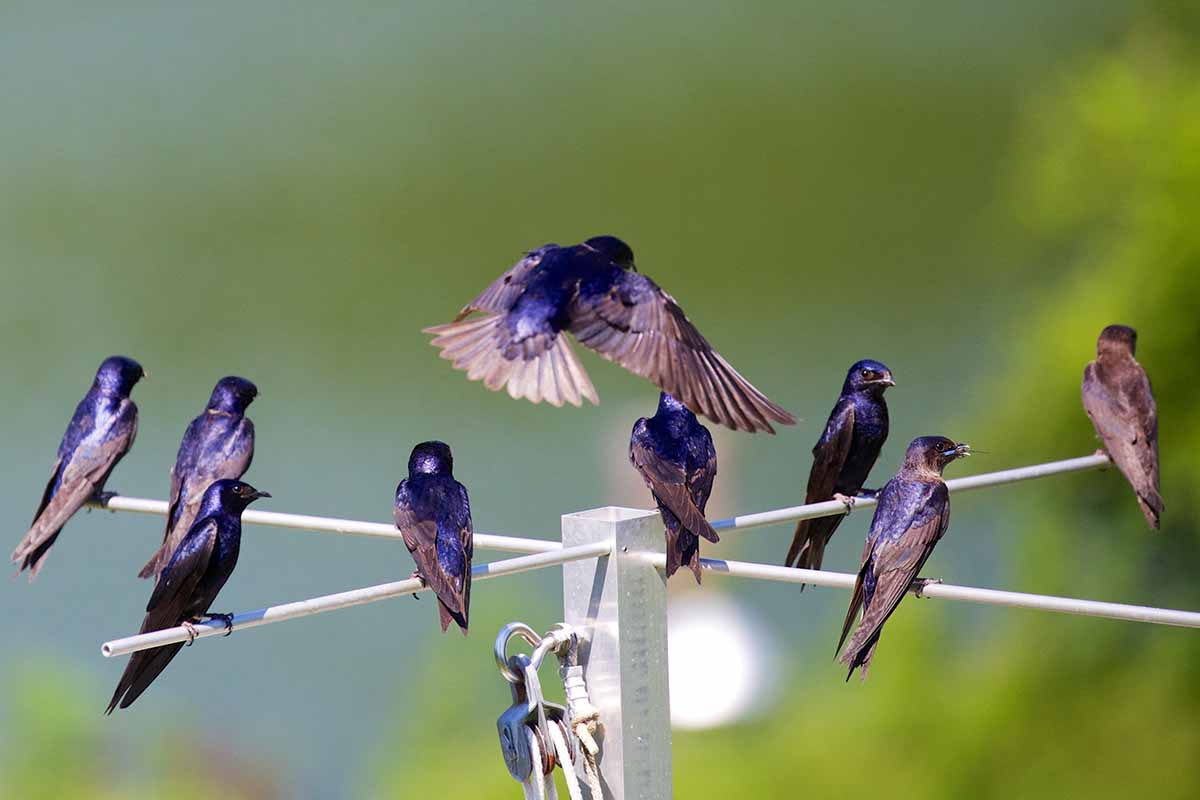
While these purple birds are not officially endangered, let’s not let them get to that point. The more of us (especially in the east) who put up welcoming lodging, the more the birds will flourish.
Let’s give them a place to roost and have young and they will reward us with their songs and their beauty.
The Ornithological Fred Astaire
The purple martin is among America’s most popular feathered friends, according to the Audubon Society. Revered for their eating habits, and loved for their singing and aerial dancing, the bird is a favorite of many gardeners.
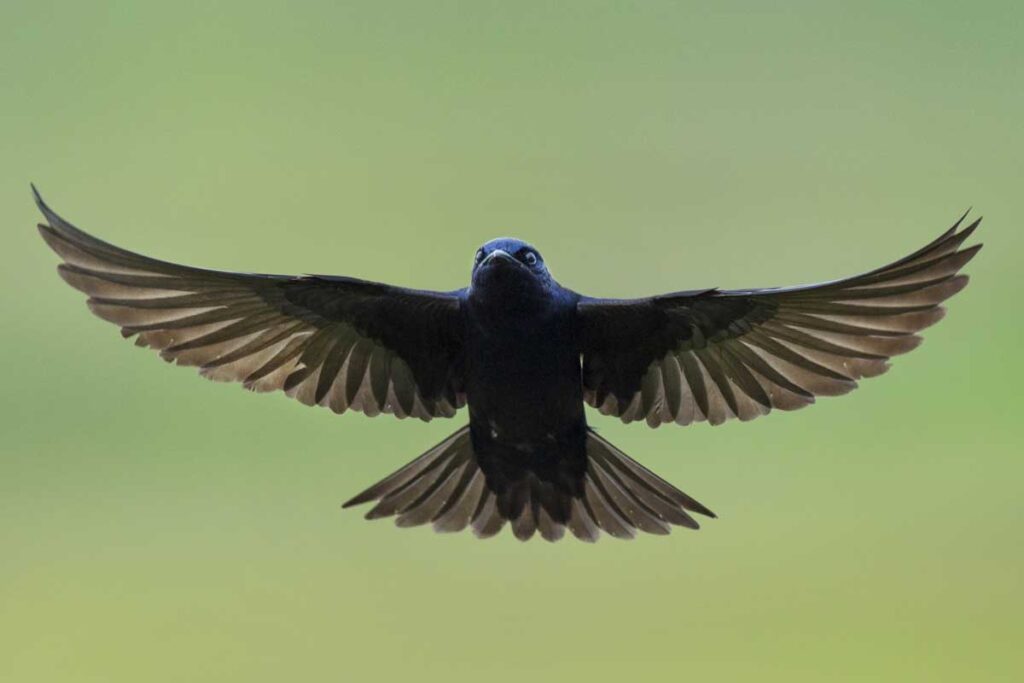
How do you attract purple martins to your yard? Will you now embark on an effort to lure these lovelies to your locale? Tell us about your martin madness in the comments section below.
Did you enjoy this guide? Check out some of our other articles that might be of interest:
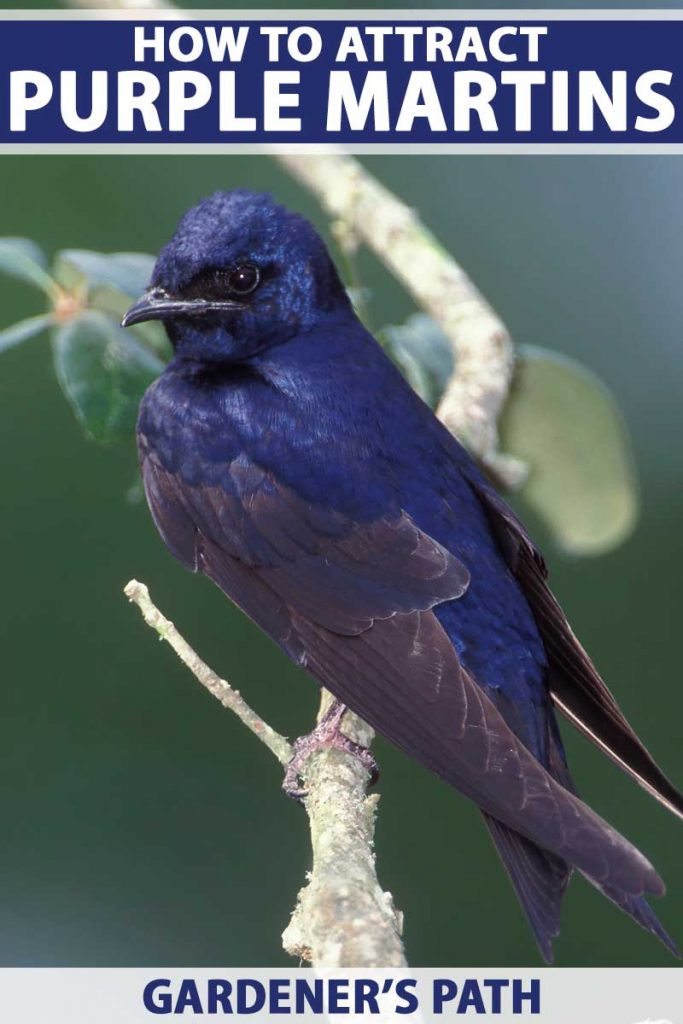
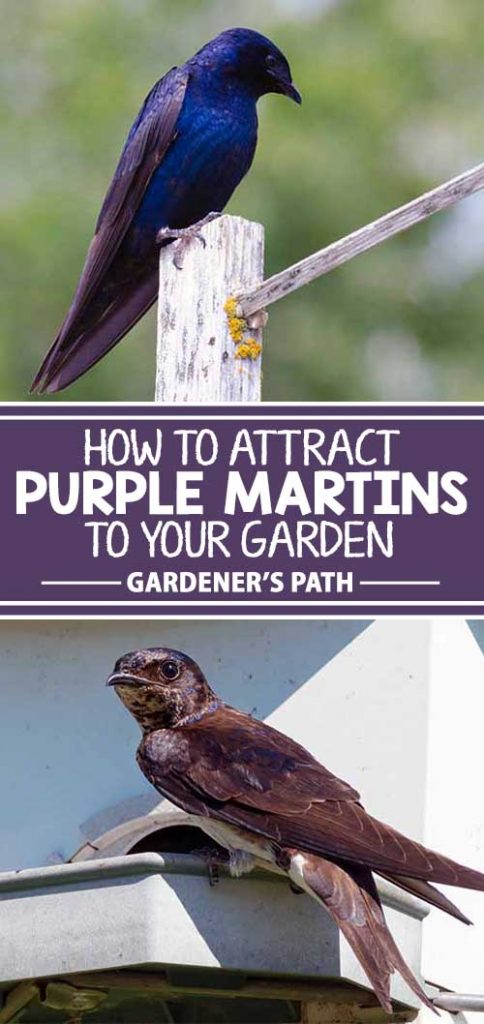
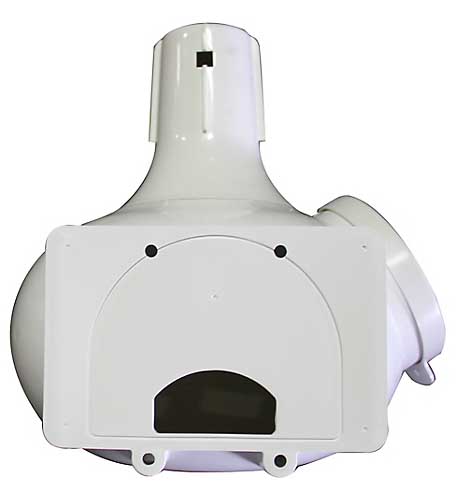

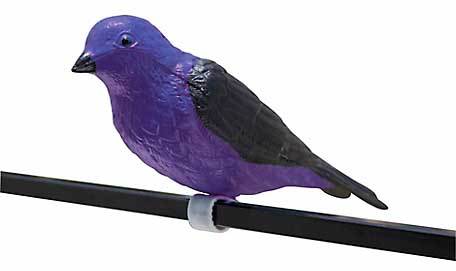
I have a 18-gourd house arrangement that is 12 feet above ground, approx 90 feet from my house and next to our garden. I have had it up for 4 years now and have done the necessary removal in the fall and put it up in the spring around 10 March each year. We put cedar shavings in each gourd each spring. There is a pond about 200 feet from the location of the houses. Around the garden is a fescue field that is put up for hay each year. There are trees in the area, but none are closer… Read more »
Sorry to hear about your experience with the baby birds, John. It can be difficult to get into the mind of a bird to determine why they may select (or reject) a given location, huh? The conditions that you describe sound nearly perfect, but maybe you can do some tinkering to see if you have better luck next year. Here are a few things to consider: The gourds themselves may be lacking- are they water-tight, painted in a reflective light color, with properly placed and sized entry holes? You said you had success in the past with a barn-style house-… Read more »
I understand one is NOT to use cedar
Thanks for the tip, Carolyn. What’s your recommendation?
I have 9 multifamily condos (all store bought). I had martins for at least 10 years in a row until 2 years ago – none in the summers of 2017 and 2018. I can’t figure out what happened. I live on about 5 acres, there is a retention pond very close and there are lots of insects. I am in central Iowa, in the Des Moines area. Any ideas how to persuade them to come back? I really missed them the past 2 summers.
Unfortunately martin numbers continue to be on the decline in many areas. You say that you’ve missed them for the past two seasons- has anything else changed that might have discouraged them from returning to your property? Installing the condos in a slightly different orientation from prior years may throw them off, or the colony that once frequented your yard may have outgrown the space. Changes in local weather patterns and the presence of predators as well as access to food may all play a role as well, though it sounds like you have insect and water availability covered. Walnut… Read more »
This is a good and helpful article. The photos are great! I’m a chalk artist and am hoping to do a “mini mural” or two at the Marty Party event on May 11, 2019, in Grand Prairie, Texas. The event is hosted by the Purple Martin Landlords of North Texas and the City of Grand Prairie’s Parks, Arts and Recreation Department. I am seeking permission to do a small chalk artwork based on the photo of the hungry babies in the gourd. Can you tell me who the photographer is and/or give me permission to do so? Thank You and… Read more »
Sounds like a wonderful project, Tammy! This is a stock image by Jean Faucett that we have license to use. Unfortunately we aren’t able to grand permission to reproduce it.
Wondering why there are no purple martins in West Pensacola?
All the houses in this area are empty. We live on Perdido Bay, and put up our first house March 1,2019. Even tried playing dawn song in am. Where are they?
Hi Connie,
Couple of things come to mind…. is your martin house in an open area? No trees or structures nearby?
Also, here in Austin, the scouts come in mid-February, so we have to have our houses cleaned up and put up by that time.
Hopefully next year they’ll find you. 🙂
Hello Connie, I am in Lillian. We had Martins for years but this year sparrows moved in. We have only two pairs of Martins in our twelve-room Martin house. If you succeed with your Martin house, never let sparrows winter in it.
Good advice, Iris. My husband usually goes out there in late winter and cleans out all the sparrow nests. Alternatively, you can just take them down after the martins have flown south.
I’m watching the dance of blue Martins today, was beautiful. This is SW ranches near Weston, FL but also they visit me in Hialeah where I have house for them.
I saw a beautiful video of the purple martin migration in Nashville this weekend- a flock of over 150,000! Glad to hear you’re able to enjoy them where you are as well, Gloria. If you have any tips for attracting them, please share!
Well Iris, I’m in Alvarado. I’m going to give this a whirl next season. Maybe we can compare notes.
Your house probably wasn’t up in time. Hopefully next year.
We have our martin house over in our pasture by our pond. Its about 500 yards from our house. We go to check our cows there every day. We have had quite a few martins this year and really enjoy them. This last week or so they have all disappeared. We looked to see if there was feathers around to see if something got them. Nothing. We noticed sometime back a sparrow in one of the cavities. What would cause them to suddenly leave that fast. It looked like they had babies earlier and we saw male & female and… Read more »
Hi Ruth…. congrats on successfully attracting the birds! My guess is that’s they’ve left to join the flock that will head south for the winter. Depending on where you live, this is about the time of year when the martins leave their nesting homes, and fly to congregate with great crowds of other martins before they fly to Brazil. Not sure how they get the signal, but somehow they know it’s time to flock together. Houston, for example, has a few of these gathering spots. I’ve heard they’re quite spectacular. The birds have some social time and then head south.
That’s good to know. I was afraid it was the sparrow(s) and I don’t know how to keep them away. By the way, we live in south central Missouri in the heart of the Ozarks. After reading your articles, we hope to be better landlords next year! Thank you!
What a wonderful source of information!We’ve enjoyed them the last two spring/ summers. Knowing more about them will make their stay more pleasurable. Thank you!
Thanks for your kind words, Dianna. We’re sad that our trees have grown so tall/full on our little suburban lot that the martins no longer visit us. But when we move to a larger property in a year or two, the martin houses will definitely come with us!
In north East Texas what is the best time of year to hang a Martin bird house?
Hi Amy – You should have your bird house in place by March at the latest, as egg laying is often underway by the beginning of April in some northern regions of East Texas.
Two of my fledgling martins are on the ground in my yard. Fortunately, I have a space nearby that they seem to feel safe in and their parents continue to check on them. Should I leave them on the ground or attempt to put them back in the Martin House? It’s been two days now that they are on the ground.
Fledgling birds (not to be confused with younger nestlings) are often seen outside the nest when they are learning how to fly, and this doesn’t necessarily mean that they are in distress – but it can be difficult to watch. Some fledglings actually spend up to several weeks hopping around on the ground in the vicinity of their nests, building muscle strength and learning to forage for food. The fact that the parents have returned to check on them is a good sign. Avoid the area, or you risk scaring them off. Attempting to return the birds to their nest… Read more »
THANK YOU Allison so very much for your response!! I’m cautiously VERY EXCITED AND HAPPY to say that I looked for our little birdy friend “Marty” this morning and I don’t see him. He was hopping around and flapping his wings yesterday, so I’m praying he finally was able to fly away with his family. His parents were always attentive, even though we’ve been deluged with thunderstorms over the past week! I really appreciate you getting back to me with all your information. My pups will be happy to be able to roam their whole yard now too!!
Hooray! You’re welcome, JoAnn!
Hello. Great article. Quick question. When is the best time to erect Martin housing in the Jacksonville FL area?
Thanks Ajax! Purple martins tend to arrive first in the southernmost areas of the country, but they also tend to have a longer migration period in these areas, spanning mid-January through March. Mid-to-late winter installation would probably be best in your area.
I live up north in the Upper Peninsula of Michigan. I just bought a purple martin housing unit with pole. Never done this before and want to do things right. Is it too late to put out yet this year, July 20th, or should I just wait til spring? To us, spring would not be til May. I like the idea of putting in cedar shavings each spring so plan on doing that, any other suggestions?
It can sometimes take several years to attract them to new housing, and the first scouts typically start arriving in this area in early April. But you don’t want to encourage other types of birds to take up residence in the meantime. Wait until four to six weeks after the first purple martins arrive next spring.